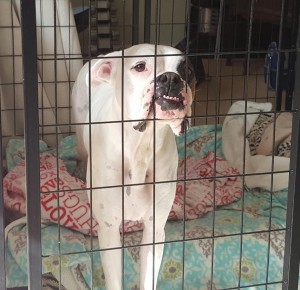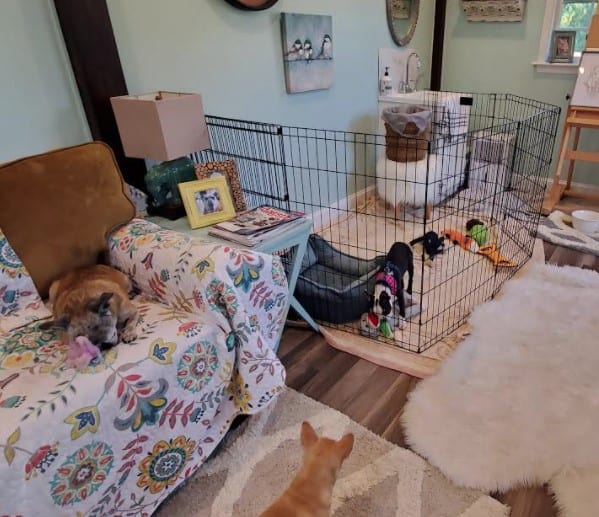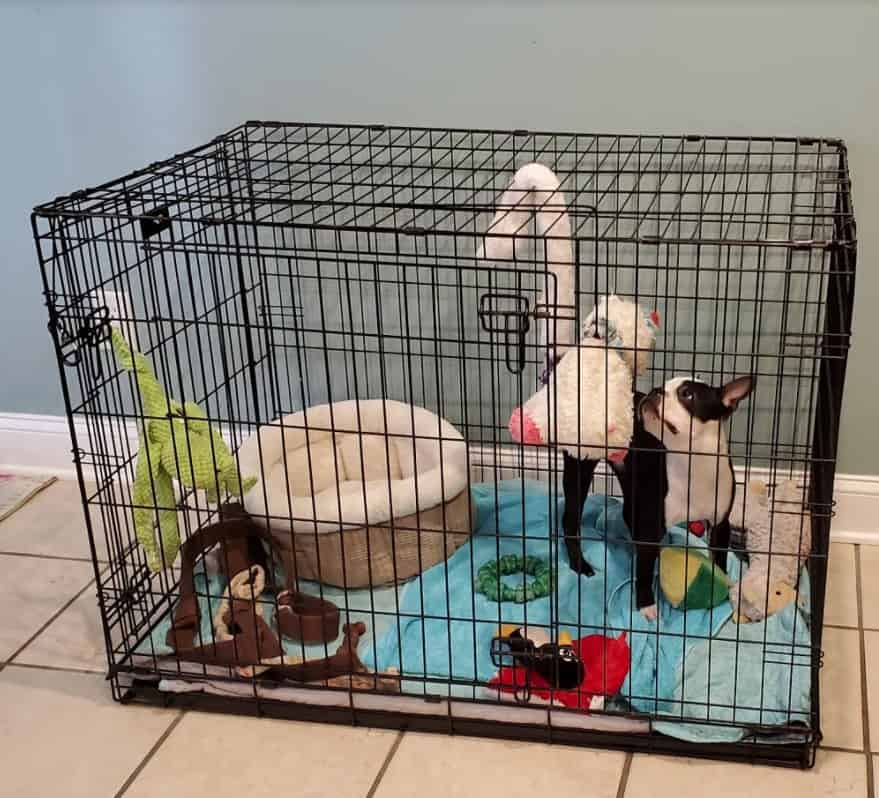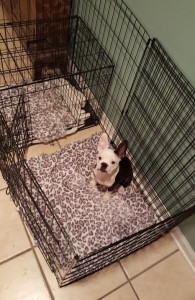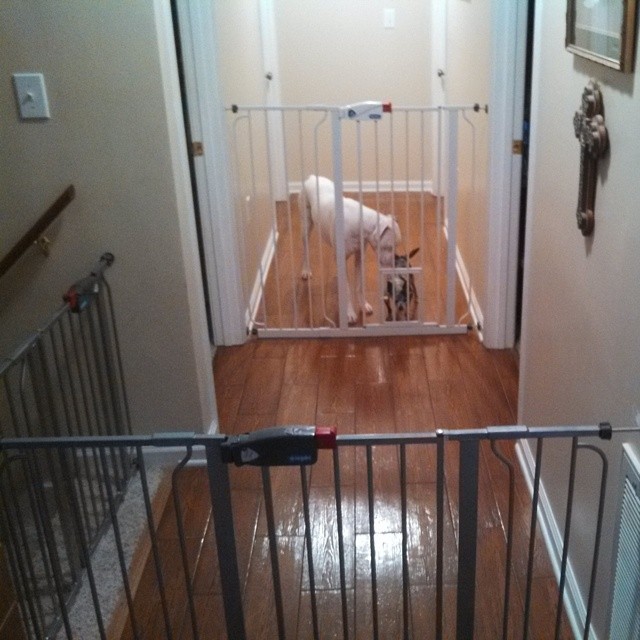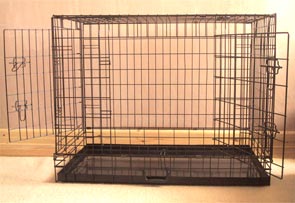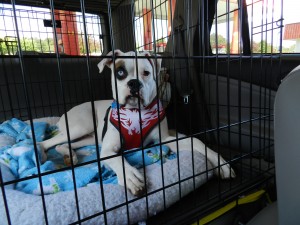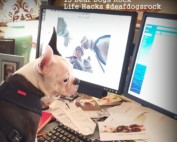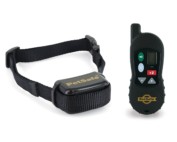One of the most common emails I get here at DeafDogsRock.com is folks trying to crate train a dog after the dog has been sleeping in a bed with humans for some time. The problem with this situation is in many cases the deaf dog has already developed separation anxiety (S.A.) because the pup was never been properly crate trained.
Once a dog has gotten used to sleeping with humans, it is very difficult to go backwards and try to get a deaf or hearing dog to except a crate. Trying to go back to a crate once the dog has developed separation anxiety (from becoming dependent on human physical contact at night) is almost impossible but it can be done.
Crate training is always our number one priority when our deaf puppies get here to the farm. We want them to think of their crate as a safe den area. This crate will keep them safe when we are away (keep them from getting into things that can harm them) and crate training is so important so if your deaf puppy needs to spend time at the vet for any reason like spay/neuter or any surgery he won’t freak out and be stressed in a crate at the vet office if you start with proper crate training on day one. Let me add that all puppies will test you and cry when they are in their crate. Be sure to watch the crate games video below.
We keep a small crate in our bedroom for our newest deaf Boston Terrier puppy Marshall and one in the main living area where we serve him his meals, he takes his naps and he gets special fun toys to play with. He takes 3 naps a day so he doesn’t get over stimulated which may cause a puppy to bite hard, chew things and just be out of control.
We also set up a special X-pen in my studio so he can hang with the other little dogs but play with his toys without any issues from the other dogs.
We also put a big play recess crate in the kitchen. Since we have 6 dogs and two will guard the toys and resources we want to make sure the puppy still has an opportunity to play with toys, play with chew bones and have fun. Marshall in the above photos scratches on his play crate all the time to get in there, play and then he will jump in his bed to take a nap. It’s a great way to keep all the dogs safe and keep them from resource guarding.
To see a training video in ASL by Savvy Dog Training with Savannah and Sydney, please click here.
Trust me when I say you do not want a deaf or hearing dog with S.A. so it is vital to implement crate training when your dog first comes into your home. Crate training your dog needs to be a positive experience for your dog. Never ever punish your dog by putting the pup in a crate but instead set up a separate time out area somewhere in your home. (read how you can establish a separate “time out” area here)
[easyazon_link identifier=”B000QFT1R2″ locale=”US” tag=”deafdogsrock-20″]MidWest make a great line of crates that are available in many sizes. Click here to view on Amazon.[/easyazon_link] I came across this video by one of my favorite positive reinforcement trainers Victoria Stilwell. I love what she does with Crate Training a puppy as far as showing the puppy when he ventures out of his crate his toys get put back into his crate. Within a few minutes the puppy figures out that if he stays inside the crate really good things happen and he gets to keep his stuffed Kong. Victoria sets up an [easyazon_link identifier=”B002904LZE” locale=”US” tag=”deafdogsrock-20″]exercise pen (X-pen)[/easyazon_link] around the crate and situates the crate inside the x-pen
Photo above – This is our deaf Boston Terrier puppy Bowie. When he got here at DDR at 10 weeks old he hated the crate. We watch the video below and also started randomly putting treats in the crate all the time. We surrounded the crate with an X-pen. After awhile Bowie would go into his crate and wait for treats. He gets all his meals in his crate and he sleeps in his crate next to my bed (I put it on an ottoman so he could see my face and I do a slow motion wave over and over like a deaf dog lullaby so he will go to sleep – always use a night light also).
Also some of the best advice I can give you for your new deaf dog or deaf puppy sleeping in his crate at night, is to have the crate in your bedroom so the dog or puppy can see you sleeping. We keep a night light on at all times when we are in our bedroom so I can check on my dogs and they can check on me (to make sure I am still there). We ended up putting two big kennels in our bedroom for our deaf boxers Bud and Nitro and a small x-pen in the middle of both kennels for our two senior hearing dogs. Nitro and Bud love their big kennels because they are so big and roomy.
[easyazon_link identifier=”B000OA7UR2″ locale=”US” tag=”deafdogsrock-20″]We use 4’x4’x6′ Lucky Dog kennels, available on Amazon, click to view[/easyazon_link] I also do a slow motion wave of my hand (up and down) like a deaf dog lullaby (over and over) until they fall asleep. Now when my deaf dogs wake up in the middle of the night crying, I can do my slow motion lullaby and they go right back to sleep (that is if they don’t have to go to the potty because sometimes they do which in that case get up and take them out to go potty). Crate training is CRUCIAL with deaf dogs and puppies. If you choose to sleep with your deaf pup in your bed they will be prone to separation anxiety which is not a fun behavior to deal with later on down the road.
A typical day here when we are crate training a deaf puppy is the following: With our deaf puppies they are out and about in our home but we must be with them and section off rooms so they don’t have free roam of the house. They get to come out for about 1.5 to 2 hours and then they nap in their crates 1-2 hours, then out for 1-2 hours then nap in their crate for 1-2 hours (all day long). It is important to note to keep them up after 8pm -10pm and keep them active in that time so they will sleep through the night. When we have a new puppy we take them out to go potty at 1am, 4am and get up at 5:30-6am. Now that Axl Blu is 4 months old if we take him out at 11pm he will sleep straight through until 5 or 6am.
If you keep everything positive about crate training (only good things happen in the pup’s crate, toys, treats, meals, naps, bedtime, ect). Like I said earlier, never ever punish your deaf dog by putting your pup in a crate. We tend to redirect and don’t use punishment and we have what we call [easyazon_link identifier=”B074SR6C6S” locale=”US” tag=”deafdogsrock-20″]”time-out zones”[/easyazon_link] in the house so we never use the dog’s crate as a negative.
A time out area can be set up with a tall gate in a hallway or another room. [easyazon_link identifier=”B074SR6C6S” locale=”US” tag=”deafdogsrock-20″]This gate is available on Amazon, click to view[/easyazon_link].
Take a look at some really helpful training tips on crate training your dog below.
)
There are lots of good articles on crate training. Here is one from dogsey.com I think has some good crate training information you can implement. We have SIX dogs here at the DDR Headquarters and all of them have been properly crate trained. I’ve noticed on YouTube that some of the well known dog trainers also using puppy pads which I totally disagree with (keep in mind this is just my personal opinion and preference) using puppy pads inside a home because it is basically telling the pup it is okay to go potty inside.
In my opinion, when people put puppy pads on the floor to train a puppy to go potty on the pad, all they are really doing is teaching the puppy or dog that it is okay to go potty inside the house. They say the smaller breeds need them because they have to go more often which may be true in some cases. I guess I’ve been lucky because my two small dogs were also crate trained the old fashioned way and it has worked like a charm. It only takes a couple of weeks of consistency to crate train your dog or puppy (that is if you follow the crate training tips mentioned below). I have SIX dogs in the house now (2 deaf and three hearing) and we never ever have “accidents” inside the house. Also with a deaf dog it helps with leaving the deaf dog in a safe place if you have to go somewhere or for traveling in the car.
TIP: When potty training a deaf puppy don’t just let him go outside in the back yard with out supervision. What happens is new deaf dog owners always complain their dog will come in the house and go potty after being outside for 20 minutes. Read more about “potty training” here.
I feed my deaf dog Nitro in his crate so he relates his crate to good things that happen to him when he goes inside his crate. If he wants a treat he usually will go into his crate and just sit and wait for a treat. When he gets tired, he will go to his crate, open the door, and put himself to bed. I do keep a cover over Nitro’s crate so it feels like his “den” and it is warm and inviting. At night it is also very important to have a night light on in your bedroom so if your deaf dog wakes up he/she can see you in bed. Make sure the crate faces your bed. I have both of my crates covered like a “dog cave” and the fronts are open so they can both see me at night. I also do a slow motion up and down wave over and over again and this always puts them right to sleep. I call it my “deaf dog lullaby” and it works like a charm especially if one of my deaf dogs wakes up in the middle of the night.
When working with a deaf dogs and their crates, the words you should be working on signing (hand signal commands) to your deaf dog are:”time to go to bed”, “get in to the crate”, “laydown”, and “go to sleep”. If you are like us we also give Nitro the “time to eat” sign and he runs right to his crate. To view a video on basic signs click here. I do understand that some dogs have been abused in crates and when they are adopted at an older age they may have fear and separation anxiety over being in a crate. With that being said, some dog owners might not be able to use a crate their dogs at all and will need to use alternative methods of training.
If you get a minuted after you read our article on crate training, please feel free to give us your thoughts in the comments section below. Thanks and happy training! ~ Christina – Deaf Dogs Rock
*Photo above: Nitro has 3 crates, one in the car, one in the living room for meals and a large one in our bedroom next to the bed for sleeping and naps.

